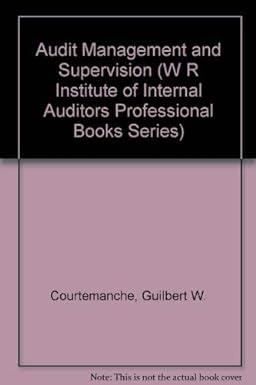Question
Corporation B has $89,000 in taxable income. What is the tax bill for this firm? What is its avegare tax rate? What is its marginal
Corporation B has $89,000 in taxable income. What is the tax bill for this firm? What is its avegare tax rate? What is its marginal tax rate? Just like the balance sheet composition the cash flow from assets equals cash flow to creditors plus cash flow to stockholders. Cash flow from assets involve three different constructs; Operating cash flow, capital spending, and change in net working capital. We will be using balance sheet example on page 24, Table 2.1 and income statement from Table 2.2 on page 27. Operating cash flow is the cash flow resulting from daily activities of producing and selling. Expenses that have to do with financing of its assets are not included in operating cash flow since they are not operating expenses. Operating cash flow therefore equals EBIT plus depreciation minus taxes. Assume EBIT is $694, depreciation is $65 and taxes are $212. Operating cash flow would be $694+$65-$212=$547. Capital spending is the net spending on fixed assets such as purchase or sale of fixed assets. Net capital spending therefore equals ending fixed assets minus beginning fixed assets plus depreciation. Assume for example that if ending fixed assets are $1,709 and beginning fixed assets and depreciation are $1,644 and $65 respectively. Net capital spending would be ($1,709-$1,644+$65) = $130. Change in net working capital is net increase or decrease in current assets over current liabilities. Assume for example that at the end of 2010 current assets and current liabilities were $1,403 and $389. Then net working capital in 2010 would be the difference between the two, $1,403 - $389 = $1,014. Similarly in 2009 net working capital would be current assets minus current liabilities in that year. Let's assume them to be $1,112, and $428 the difference would be $684. The change in net working capital then is net working capital in 2010 minus net working capital in 2009 that is $1,014-$684=$330. Now we are ready to calculate cash flow from assets. If you remember this from our earlier discussion, we calculated this by the following method. Operating cash flow - net capital spending - change in NWC. Thus, Cash flow from assets would be $547-$130-$330=$87. Lastly, cash flow to creditors is interest paid less net new borrowing whereas cash flow to stockholders is dividends paid less net new equity raised. For example, if interest paid to creditors is $70 and if long-term debt in 2010 and 2009 was $454 and $408, then cash flow to creditors would be $70 - ($454-$408) = $24 Assume dividends are equal to $103 and common stock in 2010 and 2009 were $640 and $600 respectively. Then, cash flow to stockholders wuold be $103 - ($640-$600) = $63. When we add these two items, cash flow to creditors ($24) and cash flow to stockholders ($63) it should equal cash flow from assets ($87) and indeed they are. We will just suffice for the timing being with the definition of free cash flow which is the cash the firm is free to distribute to creditors and stockholders because it is not needed for working capital or fixed asset investments.
Step by Step Solution
There are 3 Steps involved in it
Step: 1

Get Instant Access to Expert-Tailored Solutions
See step-by-step solutions with expert insights and AI powered tools for academic success
Step: 2

Step: 3

Ace Your Homework with AI
Get the answers you need in no time with our AI-driven, step-by-step assistance
Get Started


